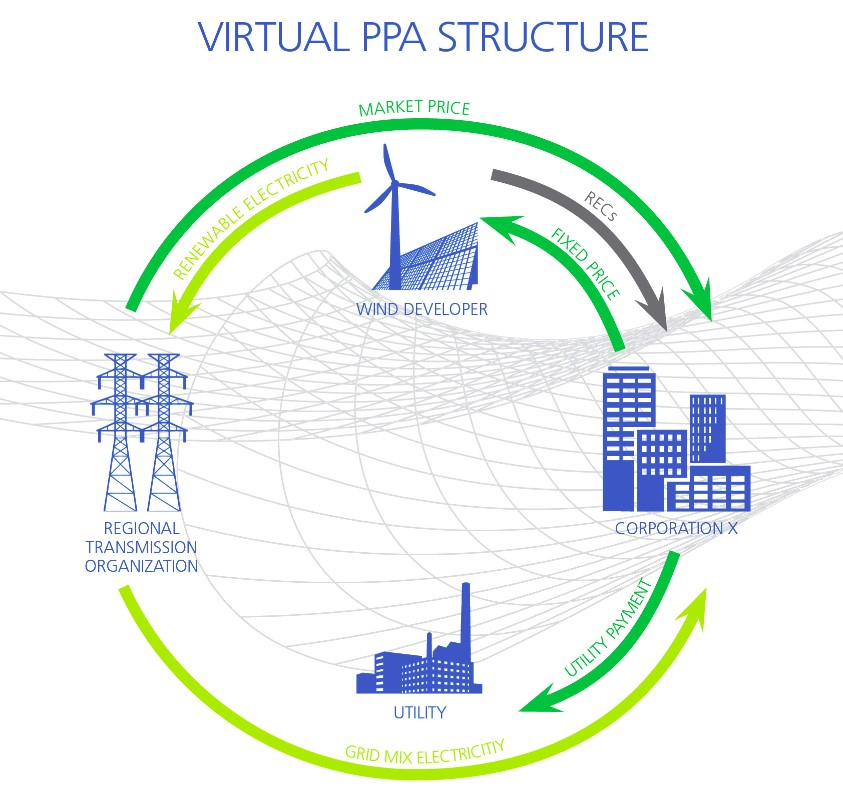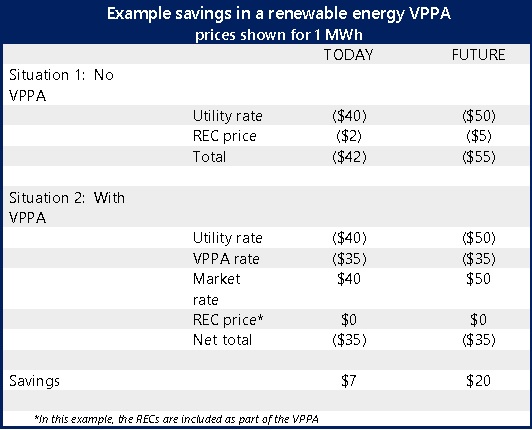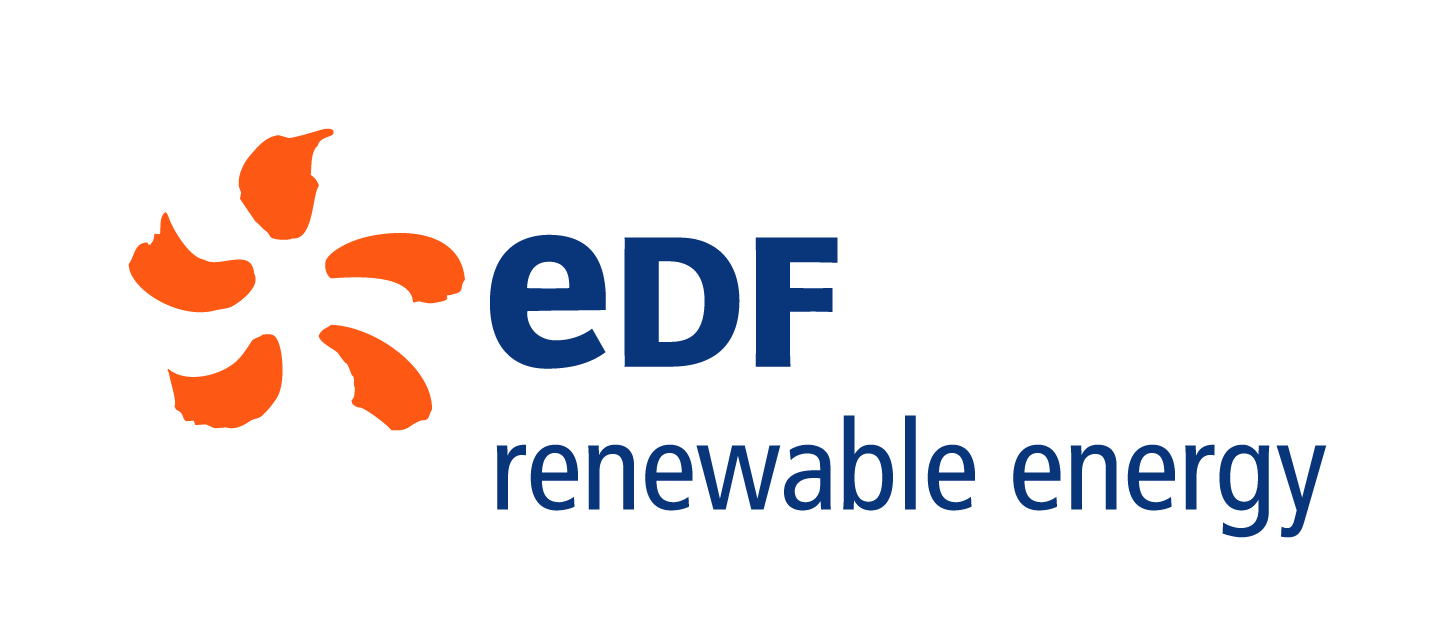Commercial, Finance, Industrial, Solar, Sourcing Renewables, Wind - October 19, 2016 - By EDF Renewable Energy
As corporations emerge as renewable energy buyers, what are their purchasing options?
Sponsored by EDF Renewable Energy
While large companies have increasingly been setting sustainability targets over the past decade, in 2016, the headlines are clear: Corporations want more renewables in their energy mix now. Fortune 500 companies have goals to reduce their carbon footprint, reduce their energy usage, and/or power a portion, or all, of their operations with renewable energy, a goal that has been made more viable as wind and solar costs continue to decline. What's more, the single most important reason for corporations to bring renewable energy into their portfolio is emerging as consumers; consumers are demanding sustainability from their industrialists.
What are the options for corporations?
- Power purchase agreements or virtual power purchase agreements, commonly referred to as PPAs or VPPAs, in which a company agrees to purchase, directly or indirectly, power at a negotiated price from a wind or solar project over a predetermined number of years.
- Direct investment, in which a company invests in a wind or solar project.
- Green tariffs, in which a company purchases green power through their local utility.
- Renewable energy credits, or RECs, which are certificates a company purchases that prove one megawatt-hour of electricity was generated from a renewable energy resource. Once the power producer has fed the electricity into the grid, the REC received can then be sold on the open market as a commodity.
Of these four contract types, VPPAs are the most common solution, with more than 75% of corporate transactions falling into the category. The VPPA is a particularly appealing option, as it offers the advantage of reducing the risk of volatile energy costs with a stable long-term price, without the need to provide an upfront capital investment.
What is a virtual power purchase agreement?
In a typical PPA, a utility would buy physical power at the bus bar of the wind farm and take title of the electron as delivered by the wind farm. A VPPA is a slight variation of a typical PPA. It involves a financial settlement whereby an organization commits to pay the wind farm’s owner a fixed price for each unit of electricity produced by the wind farm, while the wind farm takes responsibility for managing the delivery and sale of the electricity produced. The organization receives the RECs and other environmental attributes of the wind farm, but does not take delivery of or manage the flow of electrons to the electric grid. Under this structure, the organization remains connected to the local utility and continues to receive electricity and related services from that utility.
How Do VPPAs Work?
One fact we cannot debate is that electricity generated in one location cannot be directed to a specific user over the electricity grid. Once electricity is delivered to the grid there is no way to know that the electrons generated from wind farm X are going to consumer Y. That is when the VPPA deal structure comes into play.

- Company X buys electricity from a wind developer in the form of a VPPA as defined above.
- Company X will then sell that power back into the grid at the local, wholesale price. This may result in paying slightly higher prices now for the renewable energy since conventional grid power is often cheaper, but as electricity becomes more expensive over time, the price Company X locked in will lead to a profit relative to what they would have paid for grid power, the cost of which is expected to rise. In the process of selling the electricity, the RECs are retired so that no other party can claim credit for the green aspect of Company X’s purchase.
- Lastly, Company X will apply those RECs to the energy used at their facilities.
How do VPPAs add value?
VPPAs usually provide fixed price power for 15 to 25 years. By signing long-term contracts for power, organizations like Company X provide project developers with commercial offtake certainty, which unlocks the project's ability to commit construction capital. This is because VPPAs provide clean energy developers and their financiers with long-term revenue certainty.
The economic case for VPPAs
In addition to satisfying sustainability, Company X signs a VPPA contract because there is great economic value in the transaction as renewable power can be delivered at a very competitive fixed price for a long period of time. It also provides long-term price risk mitigation as described below.

Attractive long-term price
The above example demonstrates of how VPPAs can offer economic savings. In Situation 1, today the customer would pay $40/MWh to its local utility and $2/MWh to purchase RECs from the market. In contrast, in Situation 2 the customer purchases energy from the local utility but now also enters into a VPPA for $35/MWh, including RECs. The power generated by the wind project is sold into the wholesale power market at a floating price, assumed to be $40/MWh. These floating price revenues are passed back to the customer, such that it cancels out the payments under the utility bill. As a result, Situation 2 presents a net savings of a $7/MWh savings in the 'Today' case.
Risk Mitigation
The above example also highlights the potential for renewables to limit a company's market exposure by providing a hedge against potential future increases in the price of electricity. Few expect natural gas prices to remain stable, and many anticipate that the price of carbon may soon be reflected in consumers' energy bills. VPPAs allow companies to offset these rising prices.
Conclusion
Corporations, now more than ever, are taking concrete actions to achieve their sustainability goals. Whether it's purchasing RECs, signing up to green tariffs, buying renewable energy projects through a direct investment or VPPAs, the race for additionality is definitely on. According to the American Wind Energy Association 2015 Annual Report, approximately 75% of the MW contracted through PPAs in the fourth quarter – 52% of the MW contracted through PPAs during the entire year – were through nonutility companies including Procter & Gamble, General Motors and Google Energy. This trend is expected to continue because investing in clean energy make good business sense for large companies seeking to green their operations and take a more strategic approach to purchasing power. Renewable energy has passed the threshold of cost competitiveness, and now it is just a matter of time before the market, enabled by flexible new business models, makes green power the norm.
 EDF Renewable Energy is a leading U.S. independent power producer with more than 30 years of expertise in the renewable industry, covering all range of services from project origination, development, sales and marketing, to long-term asset management.
EDF Renewable Energy is a leading U.S. independent power producer with more than 30 years of expertise in the renewable industry, covering all range of services from project origination, development, sales and marketing, to long-term asset management.
Read These Related Articles:
- The Next Generation of Energy Cost Reductions
- Kimberly-Clark ramps up wind energy use
- EDF, Toyota invest in vehicle-to-grid company
- PG&E strikes energy storage deal for C&I customers
- Google signs 3 new PPAs for South Dakota, Iowa wind
Share this valuable information with your colleagues using the buttons below:
« Back to NewsStay Up-To-Date












